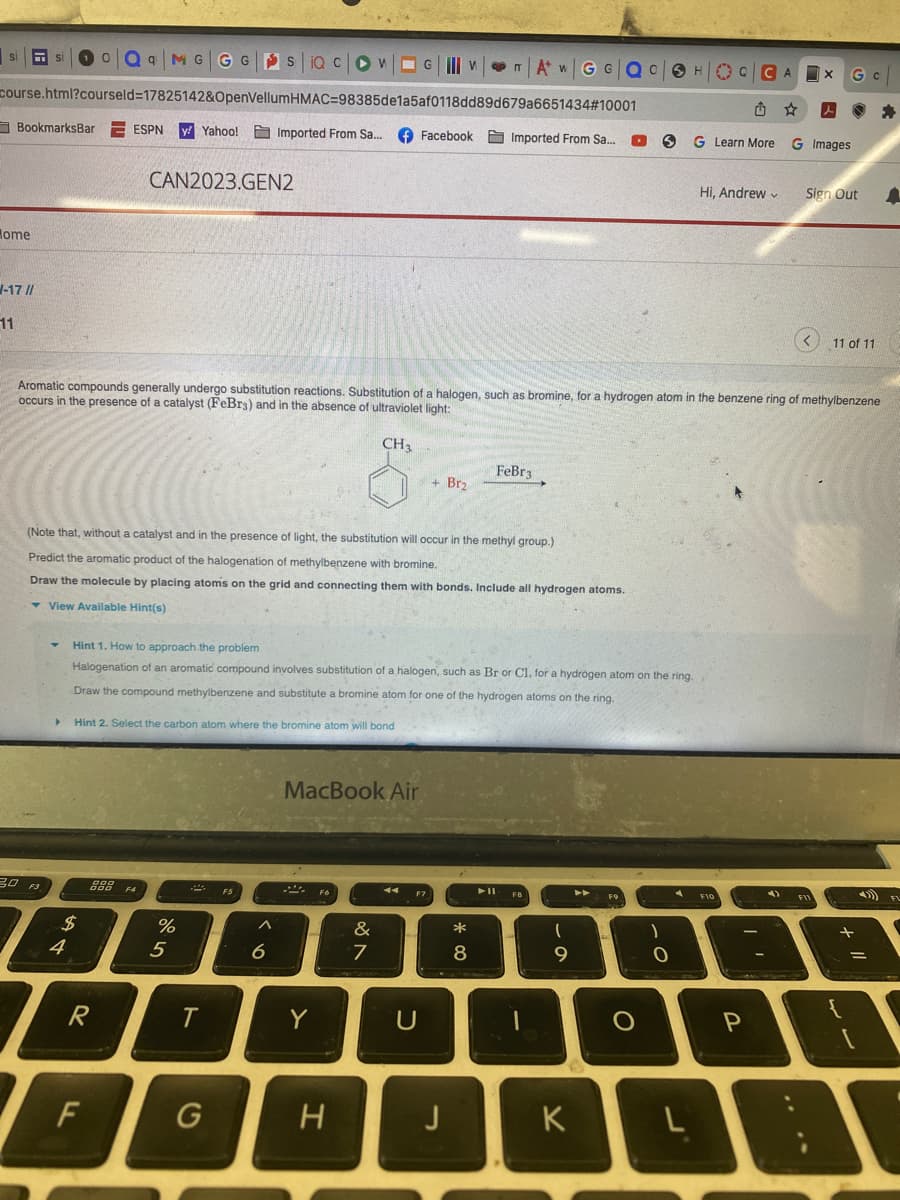Aromatic compounds generally undergo substitution reactions. Substitution of a halogen, such as bromine, for a hydrogen atom in the benzene ring of methylbenzene occurs in the presence of a catalyst (FeBrs) and in the absence of ultraviolet light: CH3 Y + Br₂ (Note that, without a catalyst and in the presence of light, the substitution will occur in the methyl group.) Predict the aromatic product of the halogenation of methylbenzene with bromine. Draw the molecule by placing atoms on the grid and connecting them with bonds. Include all hydrogen atoms. View Available Hint(s) ▸ FeBr3 Hint 1. How to approach the problem Halogenation of an aromatic compound involves substitution of a halogen, such as Br or Cl. for a hydrogen atom on the ring. Draw the compound methylbenzene and substitute a bromine atom for one of the hydrogen atoms on the ring. Hint 2. Select the carbon atom where the bromine atom will bond
Aromatic compounds generally undergo substitution reactions. Substitution of a halogen, such as bromine, for a hydrogen atom in the benzene ring of methylbenzene occurs in the presence of a catalyst (FeBrs) and in the absence of ultraviolet light: CH3 Y + Br₂ (Note that, without a catalyst and in the presence of light, the substitution will occur in the methyl group.) Predict the aromatic product of the halogenation of methylbenzene with bromine. Draw the molecule by placing atoms on the grid and connecting them with bonds. Include all hydrogen atoms. View Available Hint(s) ▸ FeBr3 Hint 1. How to approach the problem Halogenation of an aromatic compound involves substitution of a halogen, such as Br or Cl. for a hydrogen atom on the ring. Draw the compound methylbenzene and substitute a bromine atom for one of the hydrogen atoms on the ring. Hint 2. Select the carbon atom where the bromine atom will bond
Chemistry
10th Edition
ISBN:9781305957404
Author:Steven S. Zumdahl, Susan A. Zumdahl, Donald J. DeCoste
Publisher:Steven S. Zumdahl, Susan A. Zumdahl, Donald J. DeCoste
Chapter1: Chemical Foundations
Section: Chapter Questions
Problem 1RQ: Define and explain the differences between the following terms. a. law and theory b. theory and...
Related questions
Question
Part c draw the molecule by placing atoms on the grid and connecting them with bonds include all hydrogen atoms

Transcribed Image Text:sisi
course.html?courseld=17825142&OpenVellumHMAC-98385de1a5af0118dd89d679a6651434#10001
Imported From Sa...
BookmarksBar
Home
-17 //
11
20 F3
Y
▸
O O q q|MG|GG|SQ COW
$
4
ESPN y! Yahoo!
(Note that, without a catalyst and in the presence of light, the substitution will occur in the methyl group.)
Predict the aromatic product of the halogenation of methylbenzene with bromine.
Draw the molecule by placing atoms on the grid and connecting them with bonds. Include all hydrogen atoms.
View Available Hint(s)
R
F
CAN2023.GEN2
Aromatic compounds generally undergo substitution reactions. Substitution of a halogen, such as bromine, for a hydrogen atom in the benzene ring of methylbenzene
occurs in the presence of a catalyst (FeBrs) and in the absence of ultraviolet light:
CH3
888 FA
F4
Hint 1. How to approach the problem
Halogenation of an aromatic compound involves substitution of a halogen, such as Br or Cl. for a hydrogen atom on the ring.
Draw the compound methylbenzene and substitute a bromine atom for one of the hydrogen atoms on the ring.
Hint 2. Select the carbon atom where the bromine atom will bond
%
5
T
G
F5
6
MacBook Air
Y
F6
H
&
Facebook Imported From Sa... O
7
+ Br₂
F7
U
n Atw Gc QC OH CC CA
J
*
8
FeBr 3
► 11
FB
(
9
K
S G Learn More
FO
O
-0
Hi, Andrew V
L
F10
P
X G C
G Images
Sign Out
<11 of 11
F11
+
=
[
A
FI
Expert Solution
This question has been solved!
Explore an expertly crafted, step-by-step solution for a thorough understanding of key concepts.
Step by step
Solved in 4 steps with 2 images

Knowledge Booster
Learn more about
Need a deep-dive on the concept behind this application? Look no further. Learn more about this topic, chemistry and related others by exploring similar questions and additional content below.Recommended textbooks for you

Chemistry
Chemistry
ISBN:
9781305957404
Author:
Steven S. Zumdahl, Susan A. Zumdahl, Donald J. DeCoste
Publisher:
Cengage Learning

Chemistry
Chemistry
ISBN:
9781259911156
Author:
Raymond Chang Dr., Jason Overby Professor
Publisher:
McGraw-Hill Education

Principles of Instrumental Analysis
Chemistry
ISBN:
9781305577213
Author:
Douglas A. Skoog, F. James Holler, Stanley R. Crouch
Publisher:
Cengage Learning

Chemistry
Chemistry
ISBN:
9781305957404
Author:
Steven S. Zumdahl, Susan A. Zumdahl, Donald J. DeCoste
Publisher:
Cengage Learning

Chemistry
Chemistry
ISBN:
9781259911156
Author:
Raymond Chang Dr., Jason Overby Professor
Publisher:
McGraw-Hill Education

Principles of Instrumental Analysis
Chemistry
ISBN:
9781305577213
Author:
Douglas A. Skoog, F. James Holler, Stanley R. Crouch
Publisher:
Cengage Learning

Organic Chemistry
Chemistry
ISBN:
9780078021558
Author:
Janice Gorzynski Smith Dr.
Publisher:
McGraw-Hill Education

Chemistry: Principles and Reactions
Chemistry
ISBN:
9781305079373
Author:
William L. Masterton, Cecile N. Hurley
Publisher:
Cengage Learning

Elementary Principles of Chemical Processes, Bind…
Chemistry
ISBN:
9781118431221
Author:
Richard M. Felder, Ronald W. Rousseau, Lisa G. Bullard
Publisher:
WILEY